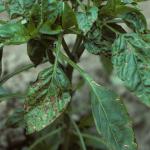Bacterial Diseases of Vegetable Crops: Leaf Spots & Blights
Plant pathogenic bacteria can cause leaf spots and blights in many vegetable crops. These diseases are most often caused by species of Pseudomonas and Xanthomonas and tend to begin as small water-soaked spots that eventually turn brown. A yellow halo may or may not be present. In severe cases, spots can coalesce and destroy entire leaves. Because bacterial infection of the leaf tissue is limited by leaf veins, bacterial leaf spots are often angular in shape; however, this may not always be the case, and non-bacterial pathogens such as the downy mildews can also cause angular leaf spots.
Management of these diseases can be challenging, both in the greenhouse and in the field. They are best controlled by an integrated pest management (IPM) plan including elements such as crop sanitation, cultivar selection, and preventative application of bactericides. It is also helpful to understand a few things about bacterial biology.
Most plant pathogenic bacteria are capable of growing at a wide range of temperatures, but each has an optimum range in which disease development is most likely to occur. For instance, Pseudomonas syringae pv. syringae, which causes a leaf spot on solanaceous crops, is most active at 61-75°F (16-24°C), while the optimum temperature range for Xanthomonas species is 77-86°F (25-30°C). Although disease development may slow or even cease at temperatures well outside the optimum, infections may simply remain quiescent until environmental conditions once again become conducive to disease.
While bacteria may sometimes be present in aerosols and can be carried on the wind, they are generally not as easily moved about by air currents as fungal spores are. Bacterial transmission between plants is most commonly facilitated by splashing water (especially wind-driven rain and overhead irrigation) and human activity. Insects may also carry bacteria on their bodies or in their saliva. Unlike many fungi, bacteria cannot penetrate host tissue directly, but instead must enter through small wounds or natural openings such as stomata and hydathodes. Plant pathogenic bacteria require the presence of free moisture for several hours in order to cause infection, and so prolonged periods of high humidity and leaf wetness are highly conducive to disease development. Cultural management practices aimed at lowering humidity and leaf wetness duration are therefore critical for disease prevention. In the greenhouse, these practices include heating and ventilating and increasing horizontal air flow by using fans. In the field, use drip irrigation instead of overhead, and plant in areas of full sun, adequate soil drainage, and good air circulation. Proper plant spacing and weed management should be employed in both scenarios.
Start with clean seeds and transplants. A good IPM program involves starting with clean seeds and transplants. Like some fungal diseases, bacterial diseases can also be seed-borne. Hot water treatment can significantly reduce the number of bacterial cells present in seed. Do not reuse flats, pots, stakes, or growing media, or save seeds from infected plants. Grow resistant varieties when available. Some bacterial pathogens (e.g. Xanthomonas campestris pv. vesicatoria, which causes leaf spot of peppers) are comprised of several races, so keep in mind that resistant cultivars may not be resistant to all races. Current information on disease resistant vegetable cultivars may be found at vegetablemdonline.ppath.cornell.edu/Tables/TableList.htm.
Field sanitation. Most plant pathogenic bacteria do not survive more than a month or two on their own in the soil; however, they can survive for much longer inside of infected plant debris in the soil and may also persist in perennial weeds. Sanitation is therefore another important cultural practice for disease prevention and management. Remove infected plants and plant debris from the greenhouse or field. It is also advisable to remove healthy looking plants adjacent to symptomatic ones. In the field, plow deeply at the end of the season to bury remaining plant debris and speed its breakdown. In no-till systems, remove crop debris as thoroughly as possible and dispose of it off-site. Rotate away from host crops for at least two years. In addition to decreasing relative humidity, good weed management also removes alternative host plants.
Chemical control. Some fungicides containing copper, copper plus mancozeb, and phosphorus acids also have bactericidal activity and are labeled for use on vegetables. Organic products based on botanical oils, Bacillus species, and other ingredients may also be helpful. Trade name of products with those active ingredients can be found in Table 25 of the New England Vegetable Management Guide. Keep in mind, however, that the efficacy of these products is limited and there is no substitute for good crop management practices.
Tips for maximizing spray efficacy include the following:
- Obtain an accurate diagnosis. With the exception of those mentioned above, most fungicides have no effect on bacteria. Knowing that a disease is caused by a bacterium and not a fungus enables the grower to select an effective product to apply, potentially saving time, money, and unnecessary applications of agrichemicals.
- Be aware that none of these products can cure a plant that is already infected, but they can help prevent healthy plants from becoming infected; therefore, they are best used as protectants.
- Thorough coverage is imperative.
- Remove symptomatic plants and plant debris from the greenhouse or field as thoroughly as possible before spraying.
- Don’t apply bactericides when plants are wet or use an air blast sprayer. The force of the air blast sprayer can spread drops of moisture containing bacteria among plants and at the same time cause small wounds through which infection can occur.
- Do not rely on copper alone for bacterial disease management. Copper-resistant strains of some plant pathogenic bacteria have been identified.
- Experimental evidence suggests that greater efficacy may be achieved when a plant defense activator like acibenzolar-s-methyl (e.g. Actigard) or extract of Reynoutria (e.g. Regalia) is included in the spray program.
The Center for Agriculture, Food and the Environment and UMass Extension are equal opportunity providers and employers, United States Department of Agriculture cooperating. Contact your local Extension office for information on disability accommodations. Contact the State Center Director’s Office if you have concerns related to discrimination, 413-545-4800 or see ag.umass.edu/civil-rights-information.




